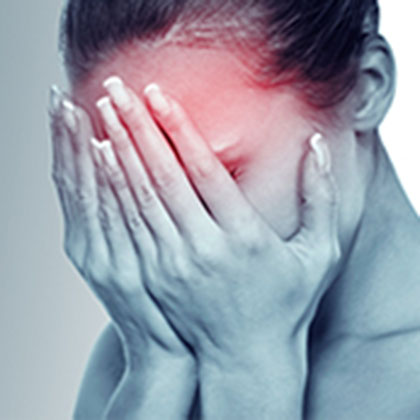
Headaches are very common, and nearly everyone has one every now and then (indeed the World Health Organization claims up to one in 20 adults has a headache every – or nearly every – day (i) ). Occipital neuralgia is a specific type of headache, though thankfully it’s quite rare: one study suggests just 3.2 people out of every 100,000 are affected by occipital neuralgia each year (ii). The London Pain Clinic also says there’s evidence the condition affects more women than men (iii).
If you have occipital neuralgia you’ll typically experience a headache that starts suddenly, causing pain in the upper neck or base of the skull and also often in the back of the head (usually on one side). The pain can often be severe – though the good news is occipital neuralgia isn’t usually linked with any serious health condition.

It’s called occipital neuralgia because it happens when one or both of your occipital nerves become irritated (pinched) or injured. There are two greater occipital nerves running either side of your head that are responsible for transmitting sensations in the back and top of your head to your brain. The nerves emerge from the spine in the upper neck area, then travel through muscles at the back of the head and into the scalp.
If either of these greater occipital nerves becomes damaged or irritated at any point, it can become inflamed and cause pain. Usually just one nerve is affected, causing pain on the corresponding side of the head – though it is possible for both nerves to become irritated at the same time, in which case pain is felt on both sides.
There’s not always a reason why it happens, but some of the things that have been blamed for causing occipital nerve damage include:
-
Injuries to the neck area – whiplash caused by a car accident or another type of trauma, for example
-
Tight, tense muscles or muscle spasms in the neck and/or back of the head
-
Back problems such as arthritis of the spine, vertebral disc degeneration and a type of inflammatory arthritis called ankylosing spondylosis
-
Blood vessel inflammation (vasculitis)
-
Repetitive neck strain (for instance, using a smartphone for long periods of times where your head is pointing downwards and forwards has been associated with occipital neuralgia (iv) )
-
Spinal cord compression
-
Infection or inflammation of the nerve
-
Physical stress
-
Tumours or cysts that put pressure on the nerves
While occipital neuralgia isn’t a life-threatening condition it can, however, have a severe impact on your quality of life.
Common symptoms
Sudden, severe and sharp pain at the base of the head where the neck meets the skull is the most common symptom of occipital neuralgia. This pain can radiate upwards, causing pain on the side of the head and as far forward as the forehead, or even behind the ear or the eye.
This pain is often described as throbbing, piercing, stabbing, burning and shooting. It can vary from one person to another – some people may find the pain is dull and throbbing, while others say it’s sharp and stabbing. Thankfully, most people who have experienced attacks of occipital neuralgia say the pain isn’t long lasting – for some it lasts just a few seconds though others may find the pain lingers for a few minutes. Some, however, also say they experience a dull ache in between attacks.
It’s also not unusual for pain to be felt in the neck, along with tightness and stiffness, as well as pain around the jaw and the mouth (including dental pain).
Sensitivity
Another common symptom of occipital neuralgia is sensitivity, typically experienced as tenderness in the area of the affected occipital nerves. This may mean you might feel pain for a few seconds whenever these areas are touched or pressed (this can help doctors diagnose occipital neuralgia as they can touch the skin directly over the occipital nerves to find out if it triggers pain).
This sensitivity can make life difficult, since simple things such as brushing or washing your hair, touching your scalp, lying down on a pillow and moving your neck can all trigger an attack. Some people affected by occipital neuralgia may also find their eyes become sensitive to light (photophobia).
Balance problems
Occipital neuralgia can affect your balance and co-ordination, causing dizziness and the symptoms of vertigo. If you experience these symptoms, you may also be affected by other related symptoms, such as:
-
Nausea
-
Vomiting
-
Slurred speech
One study also suggests some people experience tinnitus – ringing, whooshing, humming or buzzing in the ear or head – visual disturbances, nausea, dizziness or even nasal congestion when they have an occipital neuralgia attack (v).
Is it a migraine or occipital neuralgia?
It’s not always easy to tell if you have occipital neuralgia because some of the symptoms are similar to those of other conditions, including tension headaches, cluster headaches, migraine and trigeminal neuralgia (this causes pain in the face and head).
The best way to diagnose the problem is to get help from a medical professional. But there are a few differences, particularly between occipital neuralgia and migraine. These include:
Triggers
There are many potential triggers for migraine, including bright lights, strong smells, eye strain, over-exertion, low blood sugar, shock and loud noise. With occipital neuralgia, on the other hand, the main triggers are touching, moving or turning your head.
Pain type and length
Occipital neuralgia pain often comes in short, intense, sharp bursts whereas migraine pain is typically dull, throbbing and long lasting. Both, however, can cause pain on one side of the head.
Area of pain
If you have occipital neuralgia you’ll usually experience pain if you touch the back of your upper neck and the back of your scalp. This can but doesn’t usually happen in people who have migraines.
Vision symptoms
Migraine has very specific vision symptoms if you have migraine with aura, including flashing lights and blind spots. With occipital neuralgia, however, vision symptoms include blurry vision, light sensitivity and pain behind the eyes.
How is it treated?
There are a few things you can do yourself to help reduce pain if you have a mild attack of occipital neuralgia. First, find a quiet place where you can relax, then try to massage your neck muscles very gently if they are tight and painful. You could also try applying a warm compress or a heat pack to your neck, as this can help your muscles to relax too.
Changing your sleep position may also help reduce pain caused by pinched occipital nerves. Try to avoid using pillows that are too high or stiff, as it can make your neck muscles stiff and painful. Look for a pillow that supports your neck but doesn’t make your head higher than your neck.
If you do wake up with a stiff neck, try doing some gentle neck stretches:
-
Look up and extend your head backwards slightly, then lower your chin down slowly to your chest.
-
Bring your head back to the neutral position, then slowly bend it from side to side, feeling the stretch along each side of the neck.
-
Again starting in the neutral position rotate your head to one side as far as possible without triggering pain, hold for a few seconds then turn your head right around to the other side and hold.
Perform these exercises slowly and gently. If you prefer, ask your doctor to refer you to a physical therapist who can show you how to stretch and exercise your neck safely.
Pain relief
If the pain is still bad, try taking an over-the-counter anti-inflammatory painkiller such as ibuprofen. If you’ve been diagnosed with occipital neuralgia your doctor may have prescribed other painkillers designed to relieve nerve pain. Other prescription drugs that are often used to provide relief include muscle relaxants as well as certain types of antidepressants if your pain is severe.
Your doctor may also refer you to a hospital specialist called a neurologist if you have moderate to severe occipital neuralgia. Some of the treatments they may offer include the following:
Injected treatments
A specialist can inject a local anaesthetic called a nerve block into the occipital nerve at the back of the head. This can help to block pain signals coming from the nerve. It doesn’t solve the problem permanently, but it may reduce pain for several months. Steroid injections, meanwhile, can help reduce inflammation in the tissues surrounding the nerve, helping to reduce pressure on the nerve (you may have a combined local anaesthetic and steroid injection).
Another injected treatment that’s used more frequently these days for occipital neuralgia is Botulinum toxin A (more commonly known as Botox). While this may be better known as a rejuvenating cosmetic treatment, thanks to the way that it reduces the appearance of wrinkles, Botox is often used to treat several different types of headaches, including occipital neuralgia, though studies suggest it’s only effective for the sharp, shooting type of pain associated with the condition, and not dull, aching pain (vi).
Surgery
Operations to relieve the symptoms of occipital neuralgia are only usually offered in severe cases where the pain doesn’t respond to any other treatments. These operations include:
-
Microvascular decompression – where blood vessels that are putting pressure on the occipital nerve are moved or taken out. This is a major procedure that entails opening up the skull under general anaesthetic.
-
Occipital nerve stimulation – again carried out under general anaesthetic, this involves having electrodes inserted into the back of your head, under your skin. The electrodes are powered by a battery that’s implanted under the skin on your upper chest, and send mild electrical impulses that block pain signals from getting to your brain.
Natural support for occipital neuralgia
There are several nutritional supplements that may offer support if you are living with occipital neuralgia, including the following:
High-strength fish oils
The omega-3 essential fatty acids found in oily fish such as salmon, mackerel and sardines are believed to help reduce inflammation. Indeed, studies that have compared the anti-inflammatory painkiller ibuprofen and omega-3 fatty acids have found that fish oils are equally effective in reducing pain (vii). Eating oily fish may help reduce inflammation around the occipital nerves, but if you don’t like eating fish you may want to try a good-quality fish oil supplement.
Turmeric
A spice that’s become just as popular as a nutritional supplement as a means of flavouring food, turmeric contains a polyphenol substance called curcumin, which has been shown to have anti-inflammatory properties (viii) and may also be helpful for pain management (ix).
B vitamins
Many of the B vitamins are needed for a healthy nervous system, and while these are found in a wide variety of foods you may want to consider making sure you’re getting the amounts you need by taking a B complex supplement. Vitamin B12, for instance, is needed to keep your nerves working normally – if you have a vitamin B12 deficiency, it could cause nerve damage (studies suggest up to 20 per cent of older people are deficient in B12 (ix) ).
Magnesium
Eating foods that are rich in magnesium – or taking a magnesium food supplement – may help relieve muscle stiffness, since it helps muscles relax (there is, for instance, some evidence that being deficient in magnesium may lead to muscle cramps (x) ). Foods rich in magnesium include kelp, blackstrap molasses, buckwheat, wheat bran, spinach, cashews, soya beans and almonds.
Alpha lipoic acid
A sulphur-containing fatty acid, alpha lipoic acid is found in every cell of the body and is a powerful antioxidant. Some natural practitioners recommend it for nerve pain, since it’s thought that alpha lipoic acid may help support nerves against damage. Indeed in Germany, alpha lipoic acid has been widely used to treat diabetic peripheral neuropathy, a condition caused by diabetes that causes nerve damage in the arms and legs (diabetic peripheral neuropathy is often treated with the same medicines for nerve-related pain relief as occipital neuralgia).
Lecithin
As a food supplement lecithin is most often made from soya beans and contains a substance called phosphatidyl serine, which is believed to be important for brain health. It may also be useful for general nerve function and to support the nerves and neurotransmitters (molecules used by the nervous system to send messages between neurons or from neurons to muscles).
PEA
Also known as palmitoylethanolamide, PEA is a type of fatty acid that’s often recommended by natural practitioners for nerve pain and neuralgia. Made naturally by the body and found in all cells, tissues and fluids including the brain, PEA is also found in foods such as soya beans, peanuts, eggs, flaxseed and milk. Described as an endocannbinoid-like chemical that belongs to a family of fatty acid compounds called amides (xi), it’s an alternative to CBD, since both substances are thought to have similar properties including the ability to reduce pain and inflammation. However researchers suggest PEA is safer than CBD, since it has been studied more extensively and has a more robust safety profile (xi) with no known side effects (xii).
Your body naturally increases its production of PEA when your cells are damaged or threatened. But in certain situations – such as when your body is experiencing chronic inflammation – the level of PEA in your cells drops (xi). When this happens, PEA supplements may be helpful. In fact there are studies that suggest PEA may help relieve neuropathic pain significantly (xiii).
Occipital neuralgia isn’t serious but it can affect your quality of life. We hope this guide may help make it a little easier. For more information on a number of common health conditions, visit our health library
References:
-
Available online: https://www.who.int/features/qa/25/en
-
Koopman. J.S., et al. Incidence of facial pain in the general population. Pain. (2009 Dec 15). 147(1-3):122-7. Available online: https://www.ncbi.nlm.nih.gov/pubmed/19783099
-
Available online: https://www.londonpainclinic.com/conditions/occipital-neuralgia
-
Available online: http://www.bbc.co.uk/newsbeat/article/33195649/occipital-neuralgia-the-painful-condition-caused-by-your-smart-phone
-
Kuhn. W.F., Kuhn. S.C., Gilberstadt. H. Occipital neuralgias: clinical recognition of a complicated headache. A case series and literature review. J Orofac Pain. (1997 Spring). 11(2):158-65. Available online: https://www.ncbi.nlm.nih.gov/pubmed/10332322
-
Taylor. M., Silva. S., Cottrell. C. Botulinum toxin type-A (BOTOX) in the treatment of occipital neuralgia: a pilot study. Headache. (2008). 48:1476–1481. Available online: https://www.ncbi.nlm.nih.gov/pubmed/19076646. Kapural. L., Stillman. M., Kapural. M., McIntyre. P., Guirgius. M., Mekhail. N. Botulinum toxin occipital nerve block for the treatment of severe occipital neuralgia: a case series. Pain Pract. (2007). 7:337–340. Available online: https://www.ncbi.nlm.nih.gov/pubmed/17986166.
-
Maroon. J.C., Bost. J.W. Omega-3 fatty acids (fish oil) as an anti-inflammatory: an alternative to nonsteroidal anti-inflammatory drugs for discogenic pain. Surg Neurol. (2006 Apr). 65(4):326-31. Available online: https://www.ncbi.nlm.nih.gov/pubmed/16531187.
-
Aggarwal. B.B., Harikumar. K.B. Potential therapeutic effects of curcumin, the anti-inflammatory agent, against neurodegenerative, cardiovascular, pulmonary, metabolic, autoimmune and neoplastic diseases. Int J Biochem Cell Biol. (2009 Jan). 41(1):40-59. Available online: https://www.ncbi.nlm.nih.gov/pubmed/18662800.
-
Kuptniratsaikul. V., et al. Efficacy and safety of Curcuma domestica extracts compared with ibuprofen in patients with knee osteoarthritis: a multicenter study. Clin Interv Aging. (2014 Mar 20). 49:451-8. Available online: https://www.ncbi.nlm.nih.gov/pubmed/24672232.
-
Jurenka S. Anti-inflammatory Properties of Curcumin, a Major Constituent of Curcuma Longa: A Review of Preclinical and Clinical Research. Altern Med Rev. 2009;14(2):141-53.Available online: https://pubmed.ncbi.nlm.nih.gov/19594223-anti-inflammatory-properties-of-curcumin-a-major-constituent-of-curcuma-longa-a-review-of-preclinical-and-clinical-research/
-
Pennypacker. L.C., et al. High prevalence of cobalamin deficiency in elderly outpatients. J Am Geriatr Soc. (1992 Dec). 40(12):1197-204. Available online: https://www.ncbi.nlm.nih.gov/pubmed/1447433.
-
Bilbey. D.L., Prabhakaran. B.M.. Muscle cramps and magnesium deficiency: case reports. Can Fam Physician. (1996 Jul). 42:1348-51. Available online: https://www.ncbi.nlm.nih.gov/pubmed/8754704.
-
Clayton P. et al., Palmitoylethanolamide: A Natural Compound for Health Management. Int J Mol Sci. 2021 May;22(10): 5305. Available online: https://www.ncbi.nlm.nih.gov/pmc/articles/PMC8157570/
-
Clayton P. et al., Palmitoylethanolamide: A Potential Alternative to Cannabidiol. J Diet Suppl. 2021 Nov;28;1-26. Available online: https://www.tandfonline.com/doi/full/10.1080/19390211.2021.2005733
-
Paladini A. et al., Palmitoylethanolamide, a Special Food for Medical Purposes, in the Treatment of Chronic Pain: A Pooled Data Meta-analysis. Physician. 2016 Feb;19(2):11-24. Available online: https://pubmed.ncbi.nlm.nih.gov/26815246/
Related Posts
Disclaimer: The information presented by Nature's Best is for informational purposes only. It is based on scientific studies (human, animal, or in vitro), clinical experience, or traditional usage as cited in each article. The results reported may not necessarily occur in all individuals. Self-treatment is not recommended for life-threatening conditions that require medical treatment under a doctor's care. For many of the conditions discussed, treatment with prescription or over the counter medication is also available. Consult your doctor, practitioner, and/or pharmacist for any health problem and before using any supplements or before making any changes in prescribed medications.

Christine
Christine Morgan has been a freelance health and wellbeing journalist for almost 20 years, having written for numerous publications including the Daily Mirror, S Magazine, Top Sante, Healthy, Woman & Home, Zest, Allergy, Healthy Times and Pregnancy & Birth; she has also edited several titles such as Women’ Health, Shine’s Real Health & Beauty and All About Health.
View More



